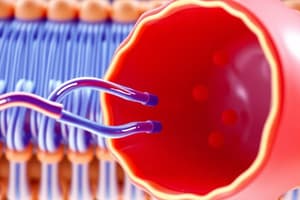Podcast
Questions and Answers
Which type of membrane transporter requires a secondary transporter to move substances against the concentration gradient?
Which type of membrane transporter requires a secondary transporter to move substances against the concentration gradient?
- Facilitated diffusion
- Active transporters (correct)
- Phospholipids
- Integral proteins
Which of the following is a component of the cytoskeleton?
Which of the following is a component of the cytoskeleton?
- Nuclear envelope
- Microtubule (correct)
- Rough Endoplasmic Reticulum
- Glycocalyx
Which type of chromatin is required to initiate transcription?
Which type of chromatin is required to initiate transcription?
- Heterochromatin
- Nucleosome
- Euchromatin (correct)
- Perinuclear space
What is the primary function of dynein in cellular processes?
What is the primary function of dynein in cellular processes?
Which specialized cells are known to be devoid of nuclei?
Which specialized cells are known to be devoid of nuclei?
Flashcards are hidden until you start studying
Study Notes
Membrane Transporters
- Membrane transporters are proteins embedded within the cell membrane.
- They facilitate the movement of substances across the membrane.
Types of Transporters
- Facilitated Diffusion: Movement of substances across the membrane with the help of a transporter protein, but without the use of energy.
- Active Transport: Movement of substances against their concentration gradient, requiring energy.
Passive Membrane Transport
- Simple Diffusion: Movement of substances across the membrane from an area of high concentration to an area of low concentration, without the need for a transporter protein or energy.
- Facilitated Diffusion: Movement of substances across the membrane with the help of a transporter protein, but without the use of energy.
Components of the Cytoskeleton
- Microtubules: Hollow tubes composed of tubulin protein, involved in cell shape, movement, and intracellular transport.
- Intermediate Filaments: Rope-like structures, composed of various proteins, providing structural support and anchoring organelles.
- Microfilaments: Actin filaments, involved in cell shape, movement, and muscle contraction.
Cytoskeletal Components
- Microtubules: Hollow tubes composed of tubulin protein, involved in cell shape, movement, and intracellular transport.
Nuclear Components
- Nucleolus: Site of ribosome synthesis.
Nuclear Structure
- Nuclear Lamina: A mesh-like network of proteins that lines the inner surface of the nuclear envelope, providing structural support and regulating nuclear processes.
- Perinuclear Space: The space between the inner and outer membranes of the nuclear envelope.
- Heterochromatin: Tightly packed, inactive form of chromatin, often located at the periphery of the nucleus.
Type of Chromatin
- Euchromatin: Loosely packed, active form of chromatin, often located in the interior of the nucleus.
Motor Proteins
- Dynein: A motor protein responsible for moving cargo towards the minus end of microtubules, often involved in intracellular transport and ciliary/flagellar movement.
Specialized Cells Without Nuclei
- Lens Cells: Lacking nuclei, these cells are specialized for light transmission in the eye.
Studying That Suits You
Use AI to generate personalized quizzes and flashcards to suit your learning preferences.




